时间介词inonat的用法
at ,in,on的具体用法 -回复

at ,in,on的具体用法-回复标题:[at, in, on]的具体用法详解在英语中,介词[at, in, on]的使用频率非常高,它们在表示时间和地点时有着不同的含义和用法。
理解并掌握这三个介词的精确用法是提升英语水平的关键步骤之一。
以下是一步一步详细解析[at, in, on]的具体用法。
一、表示时间的用法1. At:用于表示具体的时刻或者短期、特定的时间点。
示例:- I usually wake up at 6:00 am.- The meeting is scheduled at noon.- Christmas falls at the end of December.2. In:用于表示一段时间内,或者不具体的时间点。
示例:- I will be back in an hour.- She will graduate from university in four years.- In summer, we often go swimming.3. On:用于表示特定日期或者一周中的某一天。
示例:- My birthday is on May 5th.- The concert is on Saturday.- We have a staff meeting on Mondays.二、表示地点的用法1. At:用于表示在一个小的、具体的地点或者一个点的位置。
示例:- I am waiting for you at the bus stop.- He works at the post office.- They live at the corner of Main Street and First Avenue.2. In:用于表示在一个较大的区域或者空间内的位置,如城市、国家、洲等。
示例:- I was born in New York City.- They vacationed in Europe last summer.- Many pandas live in China.3. On:用于表示在物体的表面或者一个特定的位置。
介词in-on-at在表示时间时的用法
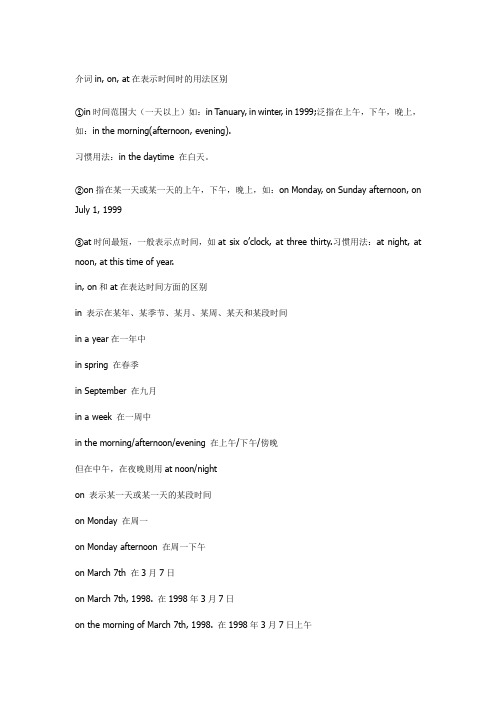
介词in, on, at在表示时间时的用法区别①in时间范围大(一天以上)如:in Tanuary, in winter, in 1999;泛指在上午,下午,晚上,如:in the morning(afternoon, evening).习惯用法:in the daytime 在白天。
②on指在某一天或某一天的上午,下午,晚上,如:on Monday, on Sunday afternoon, on July 1, 1999③at时间最短,一般表示点时间,如at six o’clock, at three thirty.习惯用法:at night, at noon, at this time of year.in, on和at在表达时间方面的区别in 表示在某年、某季节、某月、某周、某天和某段时间in a year在一年中in spring 在春季in September 在九月in a week 在一周中in the morning/afternoon/evening 在上午/下午/傍晚但在中午,在夜晚则用at noon/nighton 表示某一天或某一天的某段时间on Monday 在周一on Monday afternoon 在周一下午on March 7th 在3月7日on March 7th, 1998. 在1998年3月7日on the morning of March 7th, 1998. 在1998年3月7日上午at 表示某个具体时刻。
at eight o’clock 在8点钟at this time of the year 在一年中的这个时候at the moment 在那一时刻at that time 在那时注意:在英语中,如果时间名词前用this, last, next 等修饰时,像这样的表示,“在某时”的时间短语前,并不需要任何介词。
例如:last month, last week, this year, this week, next year, the next day, the next year 等。
介词in,on,at在表示时间时的区别
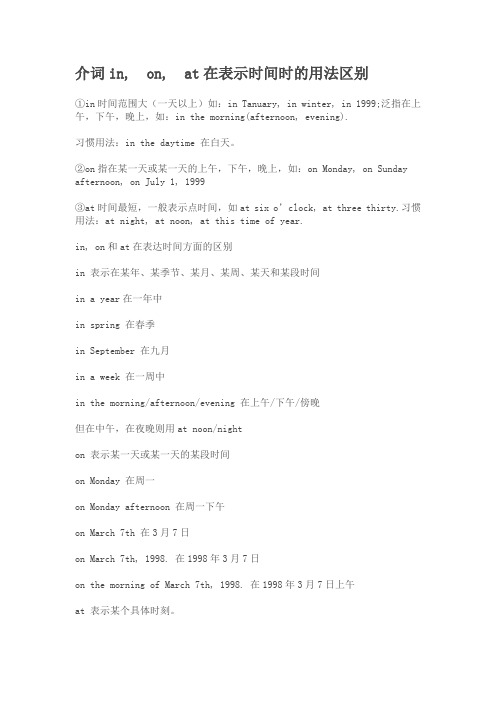
介词in, on, at在表示时间时的用法区别①in时间范围大(一天以上)如:in Tanuary, in winter, in 1999;泛指在上午,下午,晚上,如:in the morning(afternoon, evening).习惯用法:in the daytime 在白天。
②on指在某一天或某一天的上午,下午,晚上,如:on Monday, on Sunday afternoon, on July 1, 1999③at时间最短,一般表示点时间,如at six o’clock, at three thirty.习惯用法:at night, at noon, at this time of year.in, on和at在表达时间方面的区别in 表示在某年、某季节、某月、某周、某天和某段时间in a year在一年中in spring 在春季in September 在九月in a week 在一周中in the morning/afternoon/evening 在上午/下午/傍晚但在中午,在夜晚则用at noon/nighton 表示某一天或某一天的某段时间on Monday 在周一on Monday afternoon 在周一下午on March 7th 在3月7日on March 7th, 1998. 在1998年3月7日on the morning of March 7th, 1998. 在1998年3月7日上午at 表示某个具体时刻。
at eight o’clock 在8点钟at this time of the year 在一年中的这个时候at the moment 在那一时刻at that time 在那时注意:在英语中,如果时间名词前用this, last, next 等修饰时,像这样的表示,“在某时”的时间短语前,并不需要任何介词。
例如:last month, last week, this year, this week, next year, the next day, the next year等。
时间介词in on at用法

时间介词in on at用法时间介词in、on、at用法时间介词是我们日常生活中经常使用的词汇,尤其是in、on、at这三个介词,它们的用法千变万化,需要我们了解其用法,避免在进行口语和书面表达时出错。
In的用法In用来表示一段时间内,在某个时间段或时期内。
举例:I will graduate from college in two years.(我将在两年内毕业。
)She will arrive in February.(她将于二月份到达。
)In在年、月、季节、年代和特定时间段上下文中使用时都是正确的。
例如:in the 21st century(在21世纪)in the summer(在夏天)in the morning(在上午)On的用法On用来表示指定的时间和日期。
举例:I will have a meeting on Monday.(我将在星期一开会。
)His birthday falls on December 1st.(他的生日是12月1日。
)On用于特定的日期,包括:on the weekend(在周末)on Christmas Day(在圣诞节)on New Year's Eve(在新年前夜)At的用法At用于指定时间,如具体时间、夜晚、午夜、中午、日出和日落等。
举例:The meeting is at 10 o'clock.(会议在10点钟。
)We arrived at midnight.(我们在午夜抵达。
)At包括指定时间、就餐时间、课程时间和特定业务时间等。
例如:at noon(在中午)at bedtime(在睡觉时间)at rush hour(在高峰期)总结使用时间介词时,需要根据上下文和语境进行选择。
在年代、月份和季节等时间段内使用in。
在指定的日期,例如周末、圣诞节和新年夜等场合,使用on。
在具体时间、午夜、中午、日出和日落等时候,使用at。
介词用法on in at
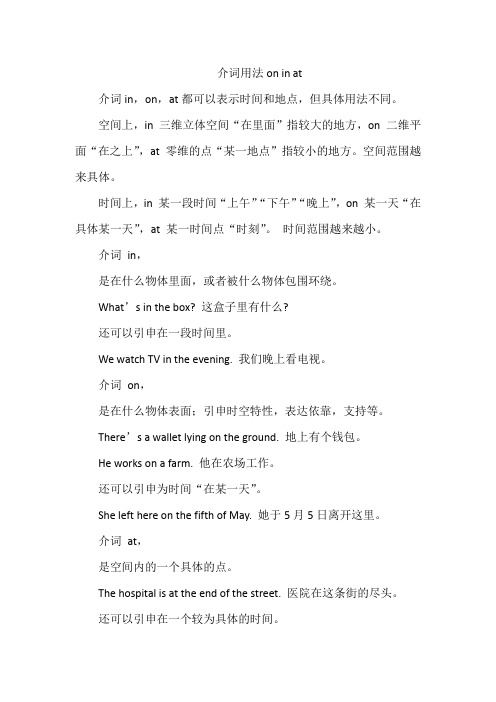
介词用法on in at介词in,on,at都可以表示时间和地点,但具体用法不同。
空间上,in 三维立体空间“在里面”指较大的地方,on 二维平面“在之上”,at 零维的点“某一地点”指较小的地方。
空间范围越来具体。
时间上,in 某一段时间“上午”“下午”“晚上”,on 某一天“在具体某一天”,at 某一时间点“时刻”。
时间范围越来越小。
介词in,是在什么物体里面,或者被什么物体包围环绕。
What’s in the box? 这盒子里有什么?还可以引申在一段时间里。
We watch TV in the evening. 我们晚上看电视。
介词on,是在什么物体表面;引申时空特性,表达依靠,支持等。
There’s a wallet lying on the ground. 地上有个钱包。
He works on a farm. 他在农场工作。
还可以引申为时间“在某一天”。
She left here on the fifth of May. 她于5月5日离开这里。
介词at,是空间内的一个具体的点。
The hospital is at the end of the street. 医院在这条街的尽头。
还可以引申在一个较为具体的时间。
She got married at the age of 25. 她25 岁结婚。
有时三者的差别与搭配习惯和用法有关:in bed在床上on the bed 在床上in the tree (多指树外之物) 在树上on the tree (多指树本身之物) 在树上。
介词inonat在表示时间时的用法区别
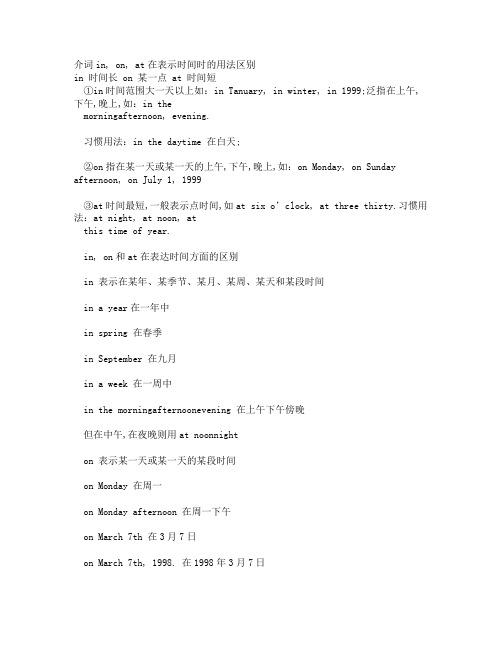
介词in, on, at在表示时间时的用法区别in 时间长 on 某一点 at 时间短①in时间范围大一天以上如:in Tanuary, in winter, in 1999;泛指在上午,下午,晚上,如:in themorningafternoon, evening.习惯用法:in the daytime 在白天;②on指在某一天或某一天的上午,下午,晚上,如:on Monday, on Sunday afternoon, on July 1, 1999③at时间最短,一般表示点时间,如at six o’clock, at three thirty.习惯用法:at night, at noon, atthis time of year.in, on和at在表达时间方面的区别in 表示在某年、某季节、某月、某周、某天和某段时间in a year在一年中in spring 在春季in September 在九月in a week 在一周中in the morningafternoonevening 在上午下午傍晚但在中午,在夜晚则用at noonnighton 表示某一天或某一天的某段时间on Monday 在周一on Monday afternoon 在周一下午on March 7th 在3月7日on March 7th, 1998. 在1998年3月7日on the morning of March 7th, 1998. 在1998年3月7日上午at 表示某个具体时刻;at eight o’clock 在8点钟at this time of the year 在一年中的这个时候at the moment 在那一时刻at that time 在那时注意:在英语中,如果时间名词前用this, last, next 等修饰时,像这样的表示,“在某时”的时间短语前,并不需要任何介词;例如:last month, last week, this year, this week, next year, the next day, thenext year等;1.What’s the weather like in springsummerautumnwinter in yourcountry你们国家春天夏天秋天冬天的天气怎么样in 在年、月、周较长时间内in a week 在里面in the room用某种语言in English 穿着in redon 某日、某日的上下午on Sunday afternoon 在……上面on the desk 靠吃……为生live on rice 关于 a book on Physics〔误〕 We got to the top of the mountain in daybreak.〔正〕 We got to the top of the mountain at day break.〔析〕 at用于具体时刻之前,如:sunrise, midday, noon, sunset, midnight, night;〔误〕 Don't sleep at daytime〔正〕 Don't sleep in daytime.〔析〕 in 要用于较长的一段时间之内,如:in the morning afternoon, 或in the week monthyear. 或 in spring supper autumn winter等等;〔误〕 We visited the old man in Sunday afternoon.〔正〕 We visited the old man on Sunday afternoon.〔析〕 in the morning, in the afternoon 如果在这两个短语中加入任何修饰词其前面的介词都要改为on, 如:on a coldmorning, on the morning of July 14th〔误〕 He became a writter at his twenties〔正〕 He became a writter in his twenties〔析〕这句话应译为:他在20多岁时就成了作家;在某人的一段生活时间段中要用介词in来表示,而在具体岁数时用at来表示;〔误〕 He went to New York to find a job in sixteen years old.〔正〕 He went to New York to find a job at sixteen.〔析〕在具体年岁前用at, 如:at the age of 12, at your age, 等等;〔误〕 We went to swim in the river in a very hot day.〔正〕 We went to swim in the river on a very hot day.〔析〕具体某一天要用介词on, 又如:on New Year's Day〔误〕 I'm looking forward to seeing you on Christmas.〔正〕 I'm looking for ward to seeing you at Christmas.〔析〕在节日的当天用on,而全部节日期间用at,Christmas是圣诞节期间,一般要有两周或更长的时间;〔误〕 I haven't see you during the summer holidays.〔正〕 I haven't seen you since the beginning of the summerholidays.〔析〕 during表示在某一段时间之内,所以一般不与完成时搭配,如:Ivisited a lot of museums during theholiday. 而for表示一段时间,可以用于完成时,如:I haven't see you for a long time. 而through用来表示时间时则为整整,全部的时间;如:It rained through thenight.而since则是表达主句动作的起始时间,一般要与完成时连用;〔误〕 At entering the classroom, I heard the good news.〔正〕 On entering the classroom, I heard the good news.〔析〕 On 加动名词表示一……就;本句的译文应是:我一进入教室就听见这个好消息了;又如:on hearing… 一听见, on arrival一到达就……on表示动作的名词〔误〕 In the beginning of the book, there are some interesting stories.〔正〕 At the beginning of the book, there are some interesting stories.〔析〕 at the begining与at the end都是指某事物的开始与结束部分,均不指时间范围,而in the beginning则是指开始一段时间;in the end=at last是指最终,终于之意;〔误〕 Till the end of next week. I will have finished this work.〔正〕 By the end of next week. I will have finished this work.〔析〕 by 引起的时间状语表示了动作的截止点,其意思为不迟于某一时刻将工作做完,所以主句一般是完成时态;当然可以有将来时态,如:I'll bethere by fiveo'clock.而till则表达其一动作一直持续到某一时刻,但句中的动词一定要用持续性动词,而瞬间的截止性动词应用其否定句式,如:I won'tfinish this work tilluntil next weekend.〔误〕 He came to London before last weekend.〔正〕 He had come to London before last weekend.〔正〕 He came to London two weeks ago.〔析〕 before 一般要与完成时连用,而ago则与一般过去时连用;〔误〕 I have studied English for three years gince I had come here.〔正〕 I have studied English for three years since I came here.〔析〕 since用来表达主句动作的开始时间,所以其引出的从句中应为过去时,而不能用完成时态〔误〕 I can help you repair this bike. You will get it after two hours.〔正〕 I can help you repair this bike. You will get it in two hours.〔析〕中文经常讲两小时之后来取,两天内会修好,而这个介词在英文中要用in 而不要用after;其原因有二,①after 多用于过去时,如:I arrivedin New York. After three days, I found a job in the bank. ② after加时间是表达一个不确定的时间范围,如:after three days, 即三天之后的哪一天都可以;所以在许诺若干时间内会完成某事时,一定要用介词in;〔误〕 Three days after he died.〔正〕 After three days he died.〔正〕 Three days later he died.〔析〕 after 与 later都可以用来表达一段时间之后,但它们所处的位置不同,after 在时间词前,而later在时间词后;〔误〕 She hid herself after the tree.〔正〕 She hid herself behind the tree.〔析〕 after多用来表达某动作之后,所以有的语法书中称它为动态介词,如:I run after him. After finishing myhomework, I went to see a film. 而behind则多用于静态事物之后;〔误〕 There is a beautiful bird on the tree.〔正〕 There is a beautiful bird in the tree.〔析〕树上长出的果实,树叶要用on, 而其他外来的人、物体均要用in the tree.〔误〕 Shanghai is on the east of China.〔正〕 Shanghai is in the east of China.〔析〕在表达地理位置时有3个介词:in, on, to; in表示在某范围之内; on 表示与某地区接壤;to则表示不相接;如:Japan is tothe east of China.〔误〕 I arrived at New York on July 2nd.〔正〕 I arrived in New York on July 2nd.〔析〕 at用来表达较小的地方,而in用来表达较大的地方;at常用于at the school gate, at home, at a bus stop,at the station, at the cinema, at a small village;〔误〕 He lived in No. 3 Beijing Road.〔正〕 He lived at No. 3 Beijing Road.〔析〕在门牌号码前要用at, 并要注意它的惯用法:at the end of the street, at the foot of themountain, at the top of the page;〔误〕 There is a colour TV set at the corner of the hall.〔正〕 There is a colour TV set in the corner of the hall.〔析〕在屋内的角落应用in,而墙的外角用at,如:There is a tree at the corner of the street.〔误〕 This weekend I'll stay in Uncle Wang's.〔正〕 This weekend I'll stay at Uncle Wang's.〔析〕要注意英文的特殊表达法,如:at a tailor's shop 裁缝店=at a tailor's, at the doctor's去看病 at the bookseller's 在书店 at uncle Wang's 在王叔叔家〔误〕 Do you know there is some good news on today's newspaper〔正〕 Do you know there is some good news in today's newspaper〔析〕在报纸上的新闻要用in, 而在具体某一版上,或某一页上则要用on;〔误〕 The school will begin on September 1st.〔正〕 School will begin on September 1st.〔析〕这里的school应看作不可数名词泛指学校的课程,即开学之意;要注意,有些活动场所当表达正在从事该种活动时不要加冠词,如:at table吃饭, When I came to Tom's home, they were at table. 还有: at desk 学习,at work工作 at school 上学, in hospital 住医院 at church 作礼拜如加上定冠词则另有他意,如:at theschool 即在学校工作或办事,in the hospital 即在医院工作或去看望病人;〔误〕 In my way to the station, I bought a newspaper to kill time.〔正〕 On my way to the station, I bought a newspaper to kill time.〔析〕译文为:在去车站的路上我买了份报纸,为的是消磨时光在……的路上应用on one's way…;而 in the way有挡道之意,如:Please move the chair it is in the way;。
at on in 跟时间的用法

at on in 跟时间的用法
在表示时间的用法中,我们使用 at、on、in 来指示不同的时间概念。
下面是它们的用法:
1. "at" 表示具体的时间点或某个特定的时刻。
例如:
- I have a meeting at 9 o'clock.(我有一个会议在九点。
)- She usually goes to bed at midnight.(她通常在午夜睡觉。
)
2. "on" 主要用于日期、星期几和节日等特定的日子。
例如:
- My birthday is on August 10th.(我的生日是在8月10日。
)
- We always have a family gathering on Christmas Day.(我们总是在圣诞节这一天举行家庭聚会。
)
3. "in" 用于表示一个时间段、月份、季节或年份等。
例如:
- I will go on vacation in July.(我将在七月去度假。
)- The flowers bloom in spring.(花朵在春天开放。
)
- He was born in 1990.(他出生于1990年。
)
需要注意的是,具体使用哪个词取决于所表达的时间概念,因此在具体场景中,可能需要根据语境来确定使用哪个词。
on at in 的用法

"on","at"和"in"是英语中常用的介词,它们在不同的语境中有不同的用法。
1. "on"的用法:- 用于表示物体表面的接触,如"on the table"(在桌子上)。
- 用于表示时间和日期,如"on Monday"(在星期一)或"on January 1st"(在1月1日)。
- 用于表示通过某种方式或手段,如"on foot"(步行)或"on the radio"(在广播中)。
2. "at"的用法:- 用于表示地点或位置,如"at home"(在家)或"at the park"(在公园)。
- 用于表示时间和日期,如"at 3 o'clock"(在3点)或"at Christmas"(在圣诞节)。
- 用于表示某种状态或情况,如"at peace"(和平)或"at war"(战争)。
3. "in"的用法:- 用于表示地点或空间,如"in the room"(在房间里)或"in the city"(在城市里)。
- 用于表示时间和日期,如"in the morning"(在早上)或"in 2022"(在2022年)。
- 用于表示某种方式或手段,如"in a car"(在车里)或"in writing"(书面)。
以上是对"on","at"和"in"用法的总结,希望对你有所帮助。
介词in,on,at用法和区别

介词at, in, on的区别1. 表示时间,注意以下用法:(1) 表示时间的某一点、某一时刻或年龄等用at。
如:I get up at six in the morning. 我早上六点钟起床。
He got married at the age of 25. 他25 岁结婚。
(2) 泛指一般意义的上午、下午或晚上以及月或年等较长的时间,一般用in。
如:We watch TV in the evening. 我们晚上看电视。
He went to Japan in 1946. 他于1946 去了日本。
(3) 若表示星期几或某一特定的日期,则用on。
如:He left here on the fifth of May. 他于5 月5 日离开这儿。
2. 表示地点、场所、位置等,注意以下用法:(1) 表示某一点位置,用at。
如:We live at No 87 Beijing Road. 我们住在北京路87 号。
The hospital is at the end of the street. 医院在这条街的尽头。
与名词所有格连用表示地点,也用at。
如:at my sister’s 在我姐姐家at the doctor’s 在医务室(2) 表示空间或范围,用in。
如:What’s in the box? 这盒子里有什么?He lives in Paris with his wife. 他同他妻子住在巴黎。
但有时两者可换用。
如:The meeting was held at [in] the hotel. 会议在宾馆举行。
(3) at 与in 的另一个区别是:at 用于指较小的地方,而in 用于指较大的地方。
如:in Shanghai 在上海at the station 在车站但是,大与小是相对的,有时随着说话者的着眼点不同,大地方也可能用at(比如把一个大地方看作一个点时)。
如:Our plane refuelled at London. 我们的飞机在伦敦加油。
介词on in at的用法口诀
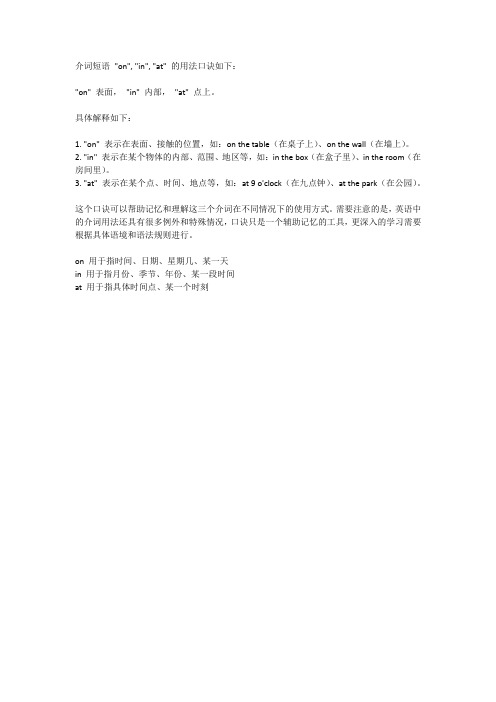
介词短语"on", "in", "at" 的用法口诀如下:
"on" 表面,"in" 内部,"at" 点上。
具体解释如下:
1. "on" 表示在表面、接触的位置,如:on the table(在桌子上)、on the wall(在墙上)。
2. "in" 表示在某个物体的内部、范围、地区等,如:in the box(在盒子里)、in the room(在房间里)。
3. "at" 表示在某个点、时间、地点等,如:at 9 o'clock(在九点钟)、at the park(在公园)。
这个口诀可以帮助记忆和理解这三个介词在不同情况下的使用方式。
需要注意的是,英语中的介词用法还具有很多例外和特殊情况,口诀只是一个辅助记忆的工具,更深入的学习需要根据具体语境和语法规则进行。
on 用于指时间、日期、星期几、某一天
in 用于指月份、季节、年份、某一段时间
at 用于指具体时间点、某一个时刻。
时间前面in,onat的区别
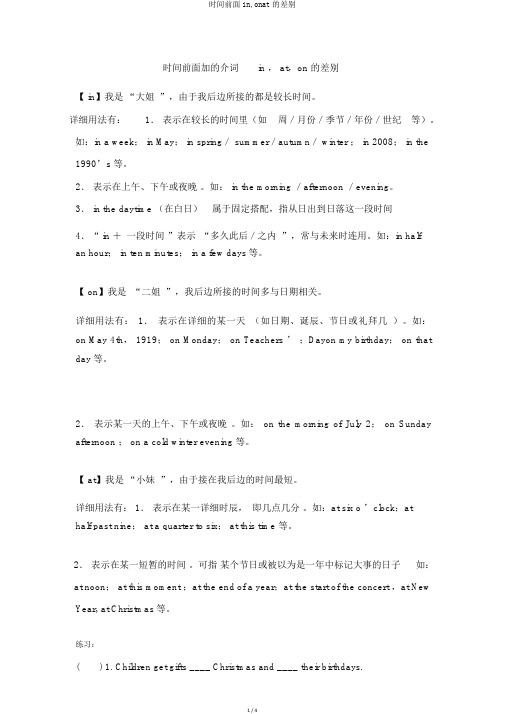
时间前面加的介词in , at,on 的差别【 in】我是“大姐”,由于我后边所接的都是较长时间。
详细用法有:1.表示在较长的时间里(如周/月份/季节/年份/世纪等)。
如:in a week; in May; in spring/ summer/autumn/ winter ; in 2008; in the 1990’s等。
2.表示在上午、下午或夜晚。
如: in the morning /afternoon /evening。
3. in the daytime (在白日)属于固定搭配,指从日出到日落这一段时间4.“ in +一段时间”表示“多久此后/之内”,常与未来时连用。
如:in halfan hour; in ten minutes; in a few days等。
【 on】我是“二姐”,我后边所接的时间多与日期相关。
详细用法有:1.表示在详细的某一天(如日期、诞辰、节日或礼拜几)。
如:on May 4th, 1919; on Monday; on Teachers ’;Dayon my birthday; on that day 等。
2.表示某一天的上午、下午或夜晚。
如:on the morning of July 2;on Sunday afternoon ; on a cold winter evening 等。
【 at】我是“小妹”,由于接在我后边的时间最短。
详细用法有: 1.表示在某一详细时辰,即几点几分。
如:at six o ’clock;athalf past nine; at a quarter to six; at this time 等。
2.表示在某一短暂的时间。
可指某个节日或被以为是一年中标记大事的日子如:at noon; at this moment ;at the end of a year;at the start of the concert ,at New Year, at Christmas等。
in,on,at介词短语用法

一、用in的场合(1)表示“在bai某年/月/季节”这个含义时du,须用介词in.例如:zhiin 1980.(2)表示“从现在起一段时间以后”时dao,须用介词in.例如:They will go to see you in a week. (3)表示“在某世纪”时,须用介词in.例如:This machine was invented in the eighteenth century. (4)表示“在某年代或特定世纪某年代”时,须用介词in.例如:This incident happened in the 1970''''s.除此之外,morning / evening / afternoon 三个词也常跟介词in连用.二、用on的场合(1)表示“在具体的某一天”或“(在具体的某一天的)早上、中午、晚上”等,须用介词on.例如:on May 10th,1982,on a rainy morning,on a summer afternoon.(2)表示“在星期几”或“在星期几的早上、中午、晚上”等,须用介词on.例如:on weekdays,on Saturday morning.(3)表示“在某一节日”时,须用介词on.例如:on Mid-autumn Festival,on Teachers''''Day. 注意:当morning,evening,afternoon被of短语修饰,习惯上用in,而不用on.例如:in the early morning of September 10th 在9月10的清晨;in the late afternoon of September 12th 在9月12日的傍晚.三、用at的场合(1)表示“某一具体时刻(即几点几分时)”,须用介词at.例如:at six(2)用在特定的时候(时节、时机)时,须用介词at.例如:They were happy at that time.他们那时很幸福.(3)表示“在中午、在夜晚、在周末”时,须用介词at.例如:What do you often do at noon?你中午经常做些什么?You can see many stars in the sky at night.夜晚你能看到天空中有许多星星.(4)表示“在……岁”时,须用介词at.例如:At the age of nine ,the boy could swim well.在九岁的时候,这孩子就游泳游得很好了.四、用by的场合by+时间名词.意为:“到…时(已发生某事),此时谓语多用完成时;最晚、不迟于…,在…之前”.如:by now/then/this time/next Friday/the end of/three o`clock等.By the end of last year,another new gymnasium had been completed.(2003上海·春)到去年年底,又有一座新体育馆峻工了.The train leaves at 6:00 pm.So I have to be at the station by 5:40 pm at the latest.(NMET97)火车下午六点开,所以最晚我得五点四十赶到车站.。
in at, on表时间

at表示时间的一点;in表示一个时期;on表示特殊日子。
例句:Can you finish the work in two days?你能在两天内完成这个工作吗?1. at后常接几点几分,天明,中午,日出,日落,开始等。
如:at five o’clock (五点),at down (黎明),at daybreak (天亮),at sunrise (日出),at noon (中午),at sunset (日落),at midnight (半夜),at the beginning of the month (月初),at that time (那时),at that moment (那会儿),at this time of day (在一天的这个时候)。
2. in后常接年,月,日期,上午,下午,晚上,白天,季节,世纪等。
如:in 2006(2006年),in May,2004 (2004年五月),in the morning (早晨/上午),in the afternoon (下午),in the evening (晚上),in the night (夜晚),in the daytime (白天),in the 21st century (21世纪),in three days (weeks/month)三天(周/个月),in a week (一周),in spring (春季)。
3. on后常接某日,星期几,某日或某周日的朝夕,节日等。
如:on Sunday (星期日),on a warm morning in April (四月的一个温暖的上午),on a December night (12月的一个夜晚),on that afternoon (那天下午),on the following night (下一个晚上),on Christmas afternoon (圣诞节下午),on October 1,1949 (1949年10月1日),on New Y ear’s Day (新年),on New Y ear’s Eve (除夕),on the morning of the 15th (15日的早上)等on,at,in用法巧记on,at,in这三个常用介词都可以表示时间和地点,但具体用法不同,多数学生对它们混淆不清。
in,on,at介词后接时间、地点

in,on,at介词后接时间、地点一. in,on,at 后接地点in 强调“在…里”(空间范围内), 后接的是大地方,例如城市,国家等;at 强调“点”,可翻译成“在…”“在…处”或者“在...旁”,后面接的是小地方,例如门牌号码前,车站,飞机场等;on 强调“在…上”(表面), 表示地点,一般指与面或线有接触in 表示在某个范围之内,没有出这个圈子,比如:in the city在城市里Wangfujing Street is in Beijing. 王府井大街在北京。
in the countryside在农村里Farmers are worming in the field. 农民们正在田间干活。
in the office 在办公室里Our village is in a valley. 我们村儿处在一个山谷里。
in the middle of the river在河的中间on 在…上(表面),表示在某个平面上或与一个面相接触,这一点和 over 与 above 是不同的。
比如:on the cover of the book. 在书的封面上on this menu. 在这菜单上on the way to…在去…的路上There are some boats on the river. 河面上有一些船儿。
They're having fun on the playground.他们正在操场上玩。
on 表在…上或者搭乘, 与 in 区别如下:on a bus 乘巴士,在公汽上 in a bus 在公汽里on a train 乘火车,在火车上 in a train 在火车里on a plane 乘飞机,在飞机上 in a plane在飞机里on a ship乘轮船,在轮船上 in a ship 在轮船里,表达的位置不一样。
at 则表示在某个具体的场所或地点,这一点和用在时间之前一样,都是在一个比较具体的、很小的“点”之前。
介词in,at,on的所有用法

in,at,on的所有用法内容:on,at,in这三个常用介词都可以表示时间和地点,但具体用法不同,不少初学者对它们混淆不清。
现在请读、记下面两个口诀,只要记住了口诀,就可避免at,on,in的种种误用。
(1)口诀之一(on,in,at表时间)。
on“在具体某一天”①“当某时”,动名词前,arrival,death记心间②;early,late位句先,用in一般“上”“下”“晚”③④;at是个时间点,“工作”“时刻”与“圣诞”⑤。
注:①on表示在具体某一天及具体某一天的上午、下午和晚上。
例:On Children’s Day,all the boys and girls are wearing their newclothes.儿童节,所有的孩子们都穿上了新衣服。
②On my arrival home,I found he had gone already.当我到家时,我发现他已经走了。
③当early,late用于句首修饰介词短语时,尽管表示具体某一天的上午、下午、晚上,都要用in(如例句1),泛指一般的上、下午,晚上也用in(如例句2)。
例:1)Early in the morning of National Day,I got up to catch the firstbus to the zoo.国庆节一清早,我便起床去赶到动物园的第一班公共汽车。
2)My father begins work at 8:00 in the morning and stops workat 4:00 in the afternoon.我父亲上午8点上班,下午4点下班。
④用于将来时态表示“过一段时间后”(如例句1)及表示“在……期间”(如例句2)和“在某个季节,某年、某月”(如例句3)都用in。
请看如下例句:1)I hear he’ll be back in a month.我听说他将于一个月后回来。
2)In the course of the last lesson in French,little Franz was listen-ing to the master very attentively.在那最后一堂法语课中,小弗朗兹非常用心地听着老师讲。
in,at和on的用法
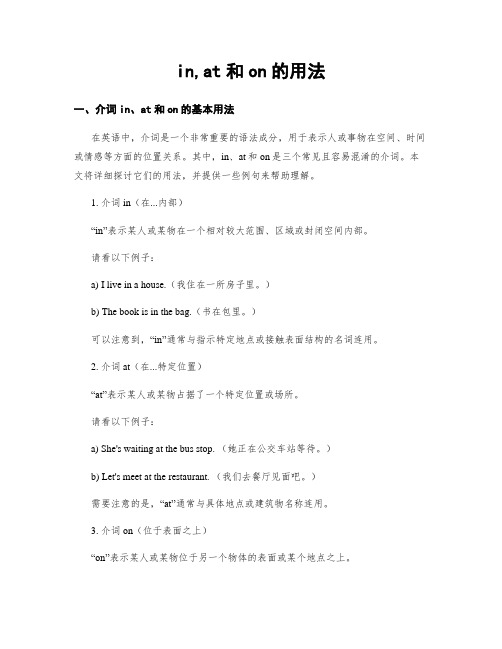
in,at和on的用法一、介词in、at和on的基本用法在英语中,介词是一个非常重要的语法成分,用于表示人或事物在空间、时间或情感等方面的位置关系。
其中,in、at和on是三个常见且容易混淆的介词。
本文将详细探讨它们的用法,并提供一些例句来帮助理解。
1. 介词in(在...内部)“in”表示某人或某物在一个相对较大范围、区域或封闭空间内部。
请看以下例子:a) I live in a house.(我住在一所房子里。
)b) The book is in the bag.(书在包里。
)可以注意到,“in”通常与指示特定地点或接触表面结构的名词连用。
2. 介词at(在...特定位置)“at”表示某人或某物占据了一个特定位置或场所。
请看以下例子:a) She's waiting at the bus stop. (她正在公交车站等待。
)b) Let's meet at the restaurant. (我们去餐厅见面吧。
)需要注意的是,“at”通常与具体地点或建筑物名称连用。
3. 介词on(位于表面之上)“on”表示某人或某物位于另一个物体的表面或某个地点之上。
请看以下例子:a) I put the cup on the table. (我把杯子放在桌子上。
)b) The cat is sitting on the chair. (猫坐在椅子上。
)可以注意到,“on”通常与接触表面或平面的物体连用。
二、in、at和on在时间表示中的用法除了表示空间位置外,in、at和on还可用于表示时间。
1. 介词in(在...期间)“in”用于表示某事发生或将要发生的某个时间段之内。
请看以下例子:a) I will see you in an hour.(一个小时后我会来见你。
)b) The concert is in December.(音乐会定于十二月举行。
)需要注意的是,“in”通常与较长的时间段连用,如小时、天、月份等。
in on at的用法及区别地点

in on at的用法及区别地点摘要:1.in、on、at在方位名词前的区别2.in、on、at在表示时间上的区别3.具体实例及练习正文:在日常英语中,in、on、at这三个介词的用法经常被混淆,尤其是在表示时间和地点时。
以下将详细解释它们在方位名词前和表示时间上的用法及区别。
一、in、on、at在方位名词前的区别1.in表示A地在B地范围之内。
例如:Taiwan is in the southeast of China.2.on表示A地与B地接壤、毗邻。
例如:North Korea is on the east of China.二、in、on、at在表示时间上的区别1.at指时间的一点、时刻等。
如:They came home at sunrise(at noon, at midnight, at ten o’clock, at daybreak, at dawn)。
2.in指时间表示:(1)在某个较长的时间(如世纪、朝代、年、月、季节以及泛指的上午、下午或傍晚等)内。
如:in 2004, in March, in spring, in the morning, in the evening。
(2)在一段时间之后。
一般情况下,用于将来时,谓语动词为瞬间动词,意为在以后。
如:He will arrive in two hours。
谓语动词为延续性动词时,in意为在以内。
如:These products will be produced in a month。
3.on指时间表示:(1)具体的时日和一个特定的时间,如某日、某节日、星期几等。
如:On Christmas Day(On May 4th),there will be a celebration。
(2)在某个特定的一天。
如:He came back on Friday。
三、具体实例及练习1.He arrived __(at/on/in) 8:00 yesterday.2.__(In/On/At) 2008, the Olympic Games were held in Beijing.3.She will __(arrive/reach/get) __(in/on/at) tomorrow.通过以上解析,我们可以更好地理解in、on、at在表示时间和地点时的用法及区别。
介词in, on, at在表示时间时的用法区别
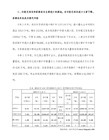
〔正〕 She hid herself behind the tree.
〔析〕 after多用来表达某动作之后,所以有的语法书中称它为动态介词,如:I run after him. After finishing my
holiday. 而for表示一段时间,可以用于完成时,如:I haven't see you for a long time. 而through
用来表示时间时则为整整,全部的时间。如:It rained through the
night.而since则是表达主句动作的起始时间,一般要与完成时连用。
in New York. After three days, I found a job in the bank. ② after
加时间是表达一个不确定的时间范围,如:after three days, 即三天之后的哪一天都可以。所以在许诺若干时间内会完成某事时,一定要用介词in。
〔误〕 Three days after he died.
〔正〕 After three days he died.
〔正〕 Three days later he died.
〔析〕 after 与 later都可以用来表达一段时间之后,但它们所处的位置不同,after 在时间词前,而later在时间词后。
in the morningafternoonevening 在上午下午傍晚
但在中午,在夜晚则用at noonnight
on 表示某一天或某一天的某段时间 y afternoon 在周一下午
on March 7th 在3月7日
- 1、下载文档前请自行甄别文档内容的完整性,平台不提供额外的编辑、内容补充、找答案等附加服务。
- 2、"仅部分预览"的文档,不可在线预览部分如存在完整性等问题,可反馈申请退款(可完整预览的文档不适用该条件!)。
- 3、如文档侵犯您的权益,请联系客服反馈,我们会尽快为您处理(人工客服工作时间:9:00-18:30)。
介词i n o n at 表示时间的用法及
区别
Step1 Teaching Aims
教学生掌握时间介词in,on 和at 的区别及用法。
Step2 Teaching Key and Difficult Points
教学生掌握时间介词in,on 和at 的区别及用法。
Step3 Teaching Procedures
1.用in 的场合后所接的都是较长时间
(1)表示“在某世纪/某年代/特定世纪某年代/年/季节/月”这个含义时,须用介词in
Eg: This machine was invented in the eighteenth century. 这台机器
是在18 世纪发明的。
She came to this city in 1980. 他于1980 年来到这个城市。
It often rains here in summer. 夏天这里常常下雨。
(2)表示“从现在起一段时间以后”时,须用介词in 。
(in+ 段时间表将来) Eg: They will go to see you in a week. 他们将在一周后去看望你。
I will be back in a month. 我将在一个月后回来。
(3)泛指一般意义的上、下午、晚上用in, in the morning / evening /
afternoon
Eg: They sometimes play games in the
他们有时在下午做afternoon.
游戏
Don't watch TV too much in the evening. 晚上看电视不要太多。
(4)A. 当morning, evening, afternoon 被of 短语修饰,习惯上应用on, 而不用in.
Eg: on the afternoon of August 1st
B. 但若前面的修饰词是early, late 时,虽有of 短语修饰,习惯上应用in, 而不用on.
Eg: in the early morning of September 10th 在9 月10 的清晨;Early in the morning of National Day, I got up to catch the first bus to the zoo. 国庆节一清早,我便起床去赶到动物园的第一班公共汽车。
2. 用on 的场合后所接的时间多与日期有关
(1)表示“在具体的某一天”或(在具体的某一天的)早上、中午、晚上”,或“在某一天或某一天的上午,下午,晚上”等,须用介词on。
Eg: Jack was born on May 10th, 1982. 杰克生于1982 年5 月10 日。
They left on a rainy morning. 他们是在一个雨天的早上离开的。
He went back to America on a summer afternoon. 他于一个夏天的下午返回了美国。
(2)表示“在星期几”或“在星期几的早上、中午、晚上”等,须用介词on。
Eg: We don't go to school on Saturday and
我们星期六和星Sunday.
期天不上学。
What time do you get up on
weekdays?
I heard this story on Saturday
morning. 个故事的。
【温馨提示】“在周末” : at weekends, on weekends. “在工作日”是 on weekdays on the weekend, at the weekend 加了定冠词 the, 是特指的那 个周末,表示某个固定的周末;
on weekends, at weekends 是一般性的每个周末。
( 3)表示“在某一节假日、生日”时,须用介词 on 。
Eg: on my birthday
Mr Hu received a card on Teachers' Day. 胡老师在教师节那天收到了一 张卡片。
We usually eat mooncakes on Mid-autumn
Festival. 吃月饼。
【温馨提示】 at, on 都可用来表示“节假日”,但 at 侧重指“休假的时节”, 而不是指具体的哪一天; on 侧重指具体的时日,与它连用的短语中多含“ Day ” at New Year ( 在新年期间 ) at Christmas ( 在圣诞节期间 ) on New Year ' s Day ( 在元旦那天 )
Christmas Day ( 在圣诞节 )你在平日什么时候起床 我是在星期六的早晨听到这
我们通常在中秋节
on
3)用于表示进餐时间。
Eg: At the age of nine ,the boy could swim
well.
3.用at 的场合 后接的时间最短
1)表示“某一具体时刻(即几点几分时)”时,用于钟点时刻前,须用介词 at 。
Eg: at ten o ' clock, at a quarter to six
He gets up at six o'clock every day.
他每天六点起床。
I got home at five thirty yesterday afternoon. 我昨天下午五点半 到家。
2)用在特定的时候(时节、时机)时,须用介词
at, 表示一瞬间或短暂的
时间 Eg: They were happy at that time.
他们那时很幸福。
I think the shop is clcsed at this time of day. 我认为商店在白天 的这个时候关门了。
at that moment (在那一瞬间) at that time 那时) Eg: at breakfast/lunch/supper ( 在早餐时 / 午餐时 / 晚餐时 )
He drinks tea at breakfast. 他在早餐时饮茶。
(4)表示“在 .. 岁”时,须用介词 at 。
在九岁的时候,这
孩子就游泳游得很好了。
5)表示“在中午、在夜晚、在周末”时,须用介词at
Eg: at noon /night /midnight (半夜), at sunrise (日出时)
at dusk (黄昏), at dawn /daybreak (黎明)
What do you often do at noon? 你中午经常做些什么
You can see many stars in the sky at night. 夜晚你能看到天空中有
许多星星。
?
Step5 Homework
Write 5 sentences with in ,on and at .。
